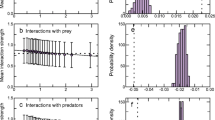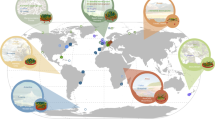Summary
An approximately constant ratio of number of predator species/number of prey species is observed in several natural communities, although the exact value of the ratio may vary with habitat and the types of organisms in the food web. We test the hypothesis that a constant predator/prey ratio can be generated by what Holt (1977) terms ‘apparent competition’ and what Jeffries and Lawton (1984) call ‘competition for enemy-free space’. We create simple, two trophic-level communities by drawing species of predators and prey at random from a species pool, simulating their interactions using Lotka-Volterra models. The simulated food webs converge over successive periods of invasion and extinction to locally stable systems with approximately constant ratios of number of predator species/number of prey species, despite varying initial conditions. As expected, predator/prey ratios take different values depending upon the ‘biology’ of the simulated species. We conclude that apparent competition between prey species via shared enemies may be one mechanism whereby approximately constant predator/prey ratios are generated in natural communities.
Similar content being viewed by others
References
Arnold SJ (1972) Species densities of predators and their prey. Am Nat 106:220–236
Beaver RA (1985) Geographical variation in food web structure in Nepenthes pitcher plants. Ecological Entomology 10:241–248
Briand F (1983) Environmental control of food web structure. Ecology 64:253–263
Briand F, Cohen JE (1984) Community food webs have a scaleinvariant structure. Nature 307:264–267
Cameron GN (1972) Analysis of insect trophic diversity in two salt marsh communities. Ecology 53:58–73
Cohen JE (1977) Ratio of prey to predators in community food webs. Nature 270:165–167
Cole BJ (1980) Trophic structure of a grassland community. Nature 288:76–77
Evans FC, Murdoch WW (1968). Taxonomic composition, trophic structure and seasonal occurrence in a grassland insect community. J Anim Ecol 37:259–273
Hairston NG, Smith FE, Slobodkin LB (1960) Community structure, population control and competition. Am Nat 94:421–425
Hassell MP (1980) The Dynamics of Arthropod Predator-Prey Systems. Princeton University Press, Princeton N.J.
Holt RD (1977) Predation, apparent competition, and the structure of prey communities. Theor Popul Biol 12:197–229
Holt RD (1984) Spatial heterogeneity, indirect interactions, and the coexistence of prey species. Am Nat 124:377–406
Jeffries MJ, Lawton JH (1984) Enemy free space and the structure of ecological communities. Biol J of the Linn Soc 23:269–286
Jeffries MJ, Lawton JH (1985) Predator-prey ratios in communities of freshwater invertebrates: the role of enemy free space. Freshwater Biol 15:105–112
Lotka AJ (1956) Elements of Mathematical Biology. Dover, New York
May RM (1973) Stability and Complexity in Model Ecosystems. Princeton University Press, Princeton N.J
Mithen SJ (1984) Growing foodwebs: a simulation model exploring constant predator prey ratios in ecological communities. Unpublished M.Sc. Thesis, University of York
Moran VC, Southwood TRE (1982) The guild composition of arthropod communities in trees. J of Anim Ecol 51:289–306
Pimm SL (1982) Food Webs. Chapman & Hall, London.
Pimm SL, Lawton JH (1977) The number of trophic levels in ecological communities. Nature 268:329–331
Post WM, Pimm SL (1983). Community assembly and food web stability. Math Biosci 64:169–192
Robinson JV, Valentine WD (1979) The concepts of elasticity, invulnerability and invadeability. J Theor Biol 81:91–104
Tregonning K, Roberts A (1978) Ecosystem-like behaviour of a random interaction model 1. Bulletin of Mathematical Biology 40:513–524
Van Valen LM (1982) A pitfall in random sampling. Nature 295:171
Williamson MH (1957) An elementary theory of interspecific competition. Nature 180:422–425
Yodzis P (1981) The stability of real ecosystems. Nature 274:674–676
Author information
Authors and Affiliations
Rights and permissions
About this article
Cite this article
Mithen, S.J., Lawton, J.H. Food-web models that generate constant predator-prey ratios. Oecologia 69, 542–550 (1986). https://doi.org/10.1007/BF00410360
Received:
Issue Date:
DOI: https://doi.org/10.1007/BF00410360




